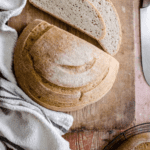Gluten-Free Artisan Sourdough bread
If you think that baking a loaf of gluten-free sourdough sounds like an impossible dream then this recipe will definitely change your mind. This incredible Gluten-Free Artisan Sourdough Bread has a cracking crust, soft and airy interior and tasty flavour. This recipe is vegan, no knead and made without any commercial yeast.
Servings: 16 slices
Calories: 194kcal
Ingredients
Levain
- 200 g active gluten-free sourdough starter
- 160 g sorghum flour
- 160 g brown rice flour
- 350 g filtered water warm
Bread
- 30 g psyllium husk not ground
- 300 g filtered water
- 125 g potato starch not potato flour
- 110 g chestnut flour
- 15 g salt
- 20 g olive oil
- 20 g soft light brown sugar
Instructions
Levain
- Whisk the sorghum flour and brown rice flour in a large glass mixing bowl then add the active starter and the filtered water. Mix together with a wooden or silicone spoon. Place cling film over the top of the bowl and allow to rest for 6-8 hours or up to 18 hours.
Bread
- Combine psyllium husk and water in a large mixing bowl or stand mixer and stir until the psyllium husk has been absorbed by the water. Allow to gel for 3-4 minutes.
- Add olive oil, sugar and mix in until smooth.
- Whisk the potato starch and chestnut flour together with the salt then add into the mixing bowl and combine.
- Finally add in the starter and mix for at least 5-10 minutes until the dough comes together.
- Turn the dough out onto a smooth and clean work surface. Roll the dough around using your hands until the dough forms a smooth ball with as few cracks as possible as these will appear on the finished bread.
- Line a banneton with a linen or muslin cloth and flour generously with brown rice flour.
- Gently lift the bread dough ball and place it inside the banneton nice side down (as it will be flipped later).
- Cover the banneton loosely with oiled cling film.
- Place the bread bread somewhere warm with a moist atmosphere for between 1-4 hours. The dough should rise by about a third.
- Pre-heat the oven to 220°C/ 200°C fan assisted oven / gas mark 7 at least 1 hour prior to baking. Place the dutch oven fitted with its lid into the oven at the same time to heat thoroughly.
- Once the bread is proved, remove the cling film and place a length of parchment or bread sling over the top of the bread and carefully insert the loaf onto the sling.
- Lower the sling with the bread on it gently into the dutch oven. (The bread is baked on top of the sling)
- Bake for 1 hour.
- Remove the lid and bake for further 10 minutes to finish browning. Remove from the oven, take the bread out of the dutch oven using the sling and slide onto a cooling rack to cool.
- Leave to cool completely before cutting to avoid gumminess.
Video
Notes
I recommend reading the whole of this post in full which has a plethora of troubleshooting tips which will help you make the perfect sourdough boule.
Flour substitutions
This recipe has not been tested with any substitutions. However feel free to experiment with your preferred flour choices. Wholegrains should be swapped for other wholegrains, starchy flours should be swapped for other starchy flours and protein flours should be swapped for other protein flours. READ MORE >>> Gluten-Free Flour CheatsheetThe Levain
The Starter
READ MORE >>> How to make a Gluten-Free Sourdough Starter Active sourdough starter. Your starter should be bubbly, mousy and sponge like. It achieves prime activation about 2-4 hours after feeding. It will have formed a slight dome on top. If the dome has deflated the starter is past prime activation. Filtered water. It should be about 40°C. The warm water helps activate the starter.Tips
- Use a glass or ceramic mixing bowl. So it doesn’t prevent the yeast from activating.
- Levain resting time. The longer you leave your levain to ferment the more sour your finished loaf will taste.
The Bread
- Psyllium husk. You can substitute for the powder but you will need less of it.
- Mix your dough for at least 5-10 minutes to ensure the starches and psyllium husk are full activated - it helps avoid a gummy loaf.
- Banneton. If you don't have a banneton (bread proving basket) then use a glass bowl lined with a muslin or linen cloth.
- Proving your bread. Prove somewhere warm with a touch of moisture. A laundry room or airing cupboard is perfect. However, my preferred method is to place my banneton on the middle shelf of a turned off oven, door closed, with a tray of just boiled water on the floor of the oven.
- Be very careful transferring your bread dough to the dutch oven, if you drop your dough in it will deflate. Handle with care.
- Don't forget to score your bread - it helps it rise.
- It is so important to allow your bread to cool completely before cutting, otherwise it will be gummy.
- The bread tastes good up to 3 days after baking then it starts to get stale.
- How to freeze. Allow your sourdough bread to fully cool then you can either freeze whole or in slices.
Nutrition
Calories: 194kcal | Carbohydrates: 40g | Protein: 3g | Fat: 3g | Saturated Fat: 1g | Polyunsaturated Fat: 1g | Monounsaturated Fat: 1g | Cholesterol: 1mg | Sodium: 373mg | Potassium: 179mg | Fiber: 4g | Sugar: 3g | Vitamin A: 4IU | Vitamin C: 3mg | Calcium: 19mg | Iron: 1mg
